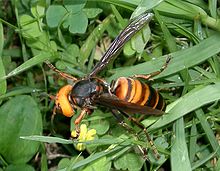Japanese giant hornet
| Japanese giant hornet | |
|---|---|

| |
| Scientific classification | |
| Kingdom: | |
| Phylum: | |
| Class: | |
| Order: | |
| Family: | |
| Genus: | |
| Species: | |
| Subspecies: | V. mandarinia japonica
|
The Japanese giant hornet (Vespa mandarinia japonica) is a subspecies of the Asian giant hornet (V. mandarinia). It is a large insect and adults can be more than 4 centimetres (1.6 in) long, with a wingspan greater than 6 centimetres (2.4 in). It has a large yellow head with large eyes, and a dark brown thorax with an abdomen banded in brown and yellow. The Japanese giant hornet has three small, simple eyes on the top of the head between the two large compound eyes. As the name implies it is endemic to the Japanese islands, where it prefers rural areas where it can find trees to nest in. [1] In Japan it is known as the ōsuzumebachi (おおすずめばち(大雀蜂、大胡蜂), literally "giant sparrow bee").
Description

Workers forage to feed their siblings. Their diet consists of a wide range of insects, including crop pests, and for this reason the hornets are regarded as beneficial. The workers dismember the bodies of their victims to return only the most nutrient-rich body parts, such as flight muscles, to the nest. There, the workers chew the prey into a paste before feeding the larvae who in return produce a fluid consumed by the workers. This fluid is known as vespa amino acid mixture (VAAM). The fluid enables intensive muscle activities over extended periods, allowing them to fly 100 kilometres (62 mi) per day and reach up to 40 kilometres per hour (25 mph). Synthetic VAAM is being produced artificially as a dietary supplement to increase athletic performance. In many Japanese mountain villages, the hornet is considered a delicacy when fried.[1]
Bee predation
In Japan, beekeepers often prefer European honey bees because they are more productive than the endemic Japanese honey bees. However, it is quite difficult to maintain a captive hive of European honey bees, as the hornets will often prey on the bees.
Once a Japanese giant hornet has located a hive of European honey bees it leaves pheromone markers around it that quickly attract nest-mates to converge on the hive. A single hornet can kill forty European honey bees in a minute; a group of 30 hornets can destroy an entire hive containing 30,000 bees in a little more than three hours. The hornets kill and dismember the bees, returning to their nest with the bee thoraxes, which they feed to their larvae, leaving heads and limbs behind. The hornets also eat the bees' honey.
The Japanese honey bee, however, has a defense against these attacks. When a hornet approaches the hive to release pheromones, the bee workers emerge from their hive in an angry cloud formation containing some 500 individuals. They form a tight ball around the hornet that acts like a convection oven when the bees vibrate their wings to direct air over their bodies, warmed by their muscular exertion, into the inside of the ball. The interior temperature of the ball rises to 47 °C (117 °F). The hornet can survive maximum temperatures of 44–46 °C (111–115 °F), but the bees can survive up to 48–50 °C (118–122 °F), so the hornet is killed and the bees survive.[1]
Venom
The Japanese giant hornet is large and fearsome, but it is not particularly aggressive unless it feels threatened. It has a venom which is injected by the 6.25 mm-long (quarter-inch) stinger and attacks the nervous system and damages tissues of its victims.[1] Tests with mice find the venom not to be among the most lethal, having an LD50 of 4.1 mg/kg, which compares to the deadliest wasp venom (to mice) by weight of Vespa luctuosa at 1.6 mg/kg. The potency of the sting is due to the relatively large amount of venom injected.[2] Being stung is extremely painful and requires hospital treatment. On average 40 people die every year of anaphylactic shock after having been stung,[1][3] which makes the Japanese giant hornet the most lethal animal in Japan (bears kill zero to five people[4] and venomous snakes kill five to ten people each year).
Notes
- ^ a b c d e Ross 2007, pp. 9–11
- ^ Schmidt et al. 1986
- ^ According to "わが国における蜂刺症 The Topic of This Month Vol.18 No.8(No.210) 国立感染症研究所", fatalities from bees and wasps are 30-40 annually in Japan(including hornets).
- ^ http://www.env.go.jp/nature/choju/docs/docs5-4a/pdfs/chpt1.pdf クマ類の出没への対応 Ministry of the Environment(Japan).
References
- Schmidt, Justin O.; Yamane, Soichi; Matsuura, Makoto; Starr, Christopher K. (1986). "Hornet venoms: Lethalities and lethal capacities" (PDF). Toxicon. 24 (9). Elsevier: 950–954. doi:10.1016/0041-0101(86)90096-6. PMID 3810666.
{{cite journal}}: Invalid|ref=harv(help) - Ross, Piper (2007). Extraordinary Animals: An Encyclopedia of Curious and Unusual Animals. pp. 9–11. ISBN 978-0-313-33922-6.
{{cite book}}: Invalid|ref=harv(help)
